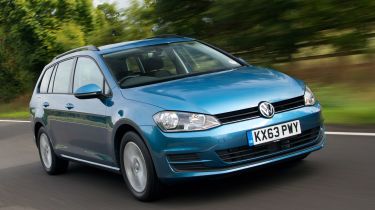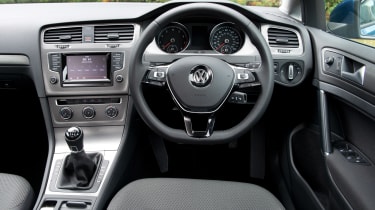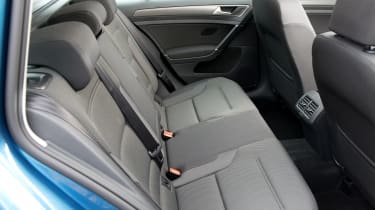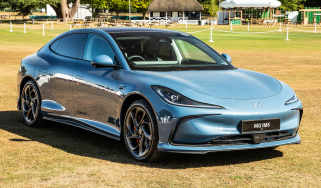Volkswagen Golf Estate (2013-2019) review
The VW Golf Estate gets a facelift, and establishes itself as a stylish, practical and appealing load lugger

The Volkswagen Golf is a mainstay of the compact hatchback market. It's currently our favourite car in the class, thanks to a mild facelift for the Mk7 at the start of 2017. And just like most of its compact hatch rivals, there's an estate variant that offers a bit more versatility. But while many rivals gain a 'sports' or 'touring' epithet to distinguish the load lugger, there's no fancy branding from VW here - it's the Golf Estate, plain and simple. That's probably a good thing, because when you consider there's also the pseudo hatch/MPV Golf SV (short for Sportvan) in the line-up, any other name would likely add confusion.
And it's the same story with the Golf Estate's looks, as the car's shape is as simple and restrained as the hatchback's. It's identical to the Golf hatch all the way back to the trailing edges of the back doors. From there, the roof continues for a bit longer, there's large windows added to the C-pillars and an additional 309mm of bodywork has been added to accommodate the bigger boot. The only other significant difference between the hatch and estate is that the rear number plate is relocated to the tailgate from the bumper, and that's about it.
Used - available now
• The best estate cars you can buy
The Golf Estate gets all the same updates as the hatchback, creating something of a Golf Mk7.5. That means more kit across the range and extra tech, too. The line-up kicks off with the S entry-model, moving up to SE, SE Navigation (no guesses what that's got over the SE) and GT, which are offered with a variety of engines. At the top of the range, there's the high-riding Alltrack, GTD fast diesel estate and ultra-rapid Golf R Estate, although VW doesn't sully its most famous performance badge by introducing a Golf GTI Estate.
New engines have been added to the Golf, including VW's three-cylinder 1.0 TSI in 110PS (109bhp) form (the hatchback's smaller 85PS version isn't offered in the Estate), the 1.4 TSI 124PS (123bhp) and the new 1.5 TSI Evo with cylinder deactivation in 130PS or 150PS guises (128bhp and 148bhp respectively). At the top of the range, the high-riding Golf Alltrack gets exclusive use of VW's 1.8 TSI 180PS engine (with 178bhp), while the high-performance Golf R uses the same 306bhp 2.0 TSI engine as the hatch version
Diesels comprise two engines, a 1.6 and 2.0 TDI. The latter 115PS unit has 113bhp, while the 150PS has 148bhp. If you want any more power than that, you need to go for the GTD, which has 181bhp. This engine is also available in the Alltrack exclusively with a DSG gearbox. The rest of the engine range comes with a manual gearbox as standard, with VW's smooth shifting DSG auto available on all engines. 4Motion four-wheel drive is standard on the Golf R and diesel Alltracks, but it's not available on any other model.
VW's estate has a wide range of rivals that includes but isn't limited to the ageing Ford Focus Estate, upmarket Hyundai i30 Tourer, smart Kia Cee’d Sportswagon, spacious Peugeot 308 SW, hi-tech Renault Megane Sport Tourer, sporty SEAT Leon ST, practical Skoda Octavia Estate and handsome Vauxhall Astra Sports Tourer.
The Volkswagen Golf has long stood as the benchmark family hatchback. However, those in need of a bit more space should look towards the more versatile Estate – it features all of the appealing touches of the standard car, but comes with a bigger boot and a more practical interior. A facelift in early 2017 brought more tech, a subtly updated look and more efficient engines, too.
There's a lot to like about the Golf Estate, with all models benefitting from strong engines, impeccable build quality, and rock-bottom running costs. It's based on the scalable MQB platform, too, which underpins everything from the Golf and Skoda Octavia, to the Audi TT and SEAT Ateca. We're huge fans of the Golf and its Estate sibling, and no matter what your requirements, there should be an engine, transmission and trim to suit all tastes.
Engines, performance and drive
From behind the wheel, the new Golf feels very similar to its predecessor. Again, this is no bad thing, because you get to revel in a driving experience that perfectly blends refinement and composure.
The Golf Estate is available with all the same engines as the hatchback, bar the potent 2.0-litre GTI. All cars are good to drive, and make light work of the extra metal hanging over the rear wheels.
All Golfs have an electric handbrake, which frees up space on the centre console, while the auto hold function helps to deliver hassle-free hill starts. You can opt for Volkswagen’s latest seven-speed DSG twin-clutch gearbox, which delivers seamless changes whether you use the shift lever or let the electronics take control. If you do the latter, the car tends to select the highest ratio possible, although it kicks down instantly whenever you need extra power for overtaking.
On the road, the Golf feels livelier than the performance figures of the lower-powered models suggest. Enter a series of corners and you’ll find the Golf responds swiftly to the direct and well weighted steering. The price you pay for the Golf’s agility is a firm ride, which is exaggerated if you upgrade to larger alloy wheels. These upgraded rims also add a touch more road noise.
Engines
There's a wide range of engines available across the Golf Estate range. The 1.6 TDI diesel has been given a 5bhp boost, to 113bhp, but torque remains unchanged at a decent 250Nm. Peak torque arrives at just 1,500rpm, so the engine copes well with the widely spaced ratios of its five-speed gearbox. The transmission benefits from a delightfully slick and precise shift action, too, but the TDI unit isn’t the most refined, emitting a noticeable clatter at idle. Fortunately, matters improve once under way, with the engine only becoming gruff and intrusive when extended.
The new 148bhp 1.5-litre turbo is very smooth and delivery brisk performance. For those who aren't munching motorway miles this new motor is definitely worth considering.
Those after a bit more speed can select the faster GTD or R versions. Both offer a surprising turn of pace – with the range-topping R featuring grippy four-wheel drive. There's no petrol-powered GTI estate, so if you want one of those, you're restricted to the smaller (but still practical) hatchback.
Lastly, is the capable and stylish Alltrack, which features raised suspension and four-wheel drive. It's as capable off-road as any compact SUV, with seamless power delivery from the all-wheel drive system over uneven surfaces and enough ground clearance to tackle steep inclines.
MPG, CO2 and Running Costs
All models in the Golf range get stop-start as standard, plus the electronic handbrake with auto hold function. The Driver Profile Selection also includes an Eco mode that adjusts the air-conditioning and throttle response to improve fuel efficiency.
The 115bhp 1.6-litre diesel model is the most efficient in the lineup; VW claims you will be able to return over 70mpg. However, a more frugal Bluemotion model is likely to be added to the lineup in due course. VW also offers a more powerful 2.0-litre diesel plus a 1.2 and 1.5-litre petrol engine, which are smooth but aren’t as efficient returning just over 55mpg.
Insurance groups
Perhaps surprisingly, all Golf Estate models sit in the same insurance groups as their hatchback equivalents. The entry-level 1.2 sits in group 7E, but high-powered models are pricier, with the GTD at 26E and the R at 34E.
Depreciation
A Golf SE costs about the same as a high-spec Octavia Elegance with DSG – and that's without spending extra on sat-nav and climate control to bring the kit tally up to the Skoda’s level. The trade-off is stronger residuals, though, as the VW is likely to hold its value better over three-years or 36,000 miles.
Interior, design and technology
The Volkswagen Golf Estate has never set the world ablaze with its looks, and it’s a similar story with the latest car. As with its hatchback sibling, the subtle facelift is so slight that if you’re not paying attention it would be easy to confuse it with its predecessor. Look closely, though, and you’ll spot the new LED tail-lights, reprofiled bumpers and revised headlamps that include LED running lamps.
SE models have 16-inch alloys that look smart, but are a bit lost in the wheelarches. Additions to the estate include roof rails – finished in silver on GT models – and 21cm of extra bodywork behind the rear wheels. It’s still 10cm shorter than a Skoda Octavia Estate, though.
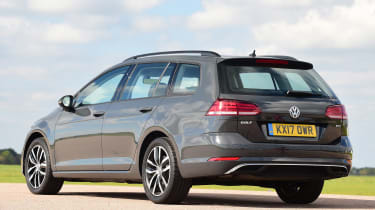
The Estate’s rear end is shaped similarly to the hatchback’s, but the number plate has moved from the bumper to the tailgate. And just like on the hatchback, the VW badge doubles as the boot release handle. Overall, the Golf Estate appears functional rather than dramatic.
Inside, the dashboard and fittings are virtually unchanged, which means it still sets the standard for quality and user-friendliness in the class. The main difference is the upgraded infotainment system, which now features an eight-inch touchscreen on all models. For an extra £1,325 you can add a larger 9.2-inch display, while the standard analogue dials can be replaced by a £495 12.3-inch digital Active Info Display. Standard kit isn’t quite as generous as some rivals, but SE Nav benefits from air-conditioning, adaptive cruise control, sat-nav and Apple CarPlay.
The new Alltrack model adds some rugged appeal with a raised ride height, chunky front and rear bumpers and unique alloy wheels. It's the most dramatic looking of all the Golf Estate options but it does come at a price.
Sat-nav, stereo and infotainment
The biggest area of advance in the Golf is the adoption of the brand’s Composition infotainment set-up. The set-up is standard on all models, with the system featuring a DAB radio, Bluetooth, USB connection and the brand’s Think Blue trip computer, which gives driving tips.
SE models and above add the desirable Car Net ‘App Connect’, which includes Apple CarPlay and Android Auto software, so you can use your smartphone's mapping software as a substitute for factory-fitted sat-nav. SE Nav models add navigation and a three-year subscription to online services.
The unit has the clearest graphics here, and the straightforward menu system is logical to use. As before, there’s a motion sensor that brings up hidden functions when your hand approaches the screen, while the hot keys respond promptly.
On Nav models you can specify the £1,325 Discover Pro system, which gets a larger 9.2-inch screen, gesture control and a 64GB memory. However, the standard set-up is easier to use, and packed with all the features you need.
Practicality, comfort and boot space
The Golf Estate is a roomy and practical car. Floor space is similar to what you get in a Skoda Octavia Estate, too, with a metre between the wheelarches. The back seats don’t fold flat, but there’s no step in the floor and it’s a metre wide for its full length. Plus, the false floor is level with the boot lip, and there’s a deep carpeted recess underneath that can accommodate both extra luggage and a space-saver spare wheel. There’s also a ski hatch in the backrest, while the seatbelts don’t get tangled in the seatbacks when you put them back up.
Size
The VW Golf sits between the SEAT Leon ST and Skoda Octavia Estate in terms of overall length – but there's only really a few millimetres in it. This is translated into bootspace, too, whereby the Golf sits bang in the middle of its siblings, boasting a 605-litre load bay. Weirdly, the Golf is the tallest but the narrowest of the three. Again, only by a few millimetres.
Leg room, head room & passenger space
Considering the Golf Estate sits below the Audi A4 and VW Passat in the Group's model range, it still offers a surprising amount of space inside. There's loads of head room and plenty of leg room, plus the driver and front seat passenger benefit from all the adjustment you'll find in the already versatile hatchback. The Skoda Octavia is bigger still, but few will complain about the space on offer.
Boot
The VW Golf Estate gets a huge 605-litre boot, which expands to 1,620 litres with the rear seats folded down. It's an extremely versatile car, and while the seats don't go completely flat, they do offer a decent (long) load area. There's a false floor, too, which allows owners to hide valuables out of sight.
Reliability and Safety
The Golf has always been a dependable car, and the current version is no different. The Mk7 Golf came a credible 17th place overall in the 2017 Driver Power owner satisfaction survey, placing it above a number of key rivals.
It’s based on VW’s MQB platform, which was designed to be used under a wide range of new models, so it’s been thoroughly tested before entering production. There have been some cases of high-mileage VW DSG gearboxes suffering from juddering, but this has affected only a small percentage of cars and the issue will have been rectified in the latest models.
The Golf achieved the maximum five stars in its Euro NCAP crash test in 2012, and has similar percentage scores to the Skoda Octavia Estate, which was tested a year later under the same regime. It's worth noting that you can't directly compare the Golf's score with some newer rivlas, because the NCAP test was made tougher in 2016.
SE models get adaptive cruise control and a driver alert system as standard, while optional driver aids include Park Assist, automatic lights and wipers, PreCrash occupant protection and lane-keeping assist. The latter can help you stay in your lane by making small steering adjustments, although in practice this seems quite unnerving and means the steering feels light and wayward in your hands.
Deals
View the latest VW Golf estate deals on our Find a Car service.
Warranty
VW’s three-year, 60,000-mile warranty is about average by industry standards, although you can extend it, at extra cost, up to a maximum of five years or 90,000 miles.
Servicing
The service schedule for the Golf is every 12 months or 10,000 miles, whichever is the sooner. Fixed-price servicing is available from VW dealers, although VW doesn’t offer the sort of low-cost all-in servicing package that many rival manufacturers do, so costs are likely to end up being higher than some competitors.

